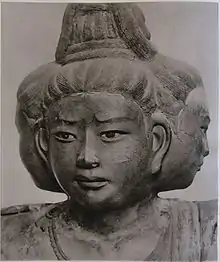
In the mid-6th century, the introduction of Buddhism from Baekje to Japan resulted in a revival of Japanese sculpture. Buddhist monks, artisans and scholars settled around the capital in Yamato Province (present day Nara Prefecture) and passed their techniques to native craftsmen. Consequently, early Japanese sculptures from the Asuka and Hakuhō periods show strong influences of continental art, which initially were characterized by almond-shaped eyes, upward-turned crescent-shaped lips and symmetrically arranged folds in the clothing. The workshop of the Japanese sculptor Tori Busshi, who was strongly influenced by the Northern Wei style, produced works which exemplify such characteristics. The Shakyamuni triad and the Guze Kannon at Hōryū-ji are prime examples. By the late 7th century, wood replaced bronze and copper. By the early Tang dynasty, greater realism was expressed by fuller forms, long narrow slit eyes, softer facial features, flowing garments and embellishments with ornaments such as bracelets and jewels. Two prominent examples of sculptures of this period are the Shō Kannon at Yakushi-ji and the Yumechigai Kannon at Hōryū-ji. During the Nara period, from 710 to 794, the government established and supported workshops called zōbussho, the most prominent of which was located in the capital Nara at Tōdai-ji, which produced Buddhist statuary. Clay, lacquer and wood, in addition to bronze, were used. Stylistically, the sculptures were influenced by the high Tang style, showing fuller body modelling, more natural drapery and a greater sense of movement. Representative examples of Nara period sculpture include the Great Buddha and the Four Heavenly Kings at Tōdai-ji, or the Eight Legions at Kōfuku-ji. (Full article...)